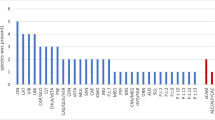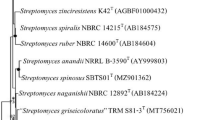Abstract
This study was aimed to isolate and identify the N2-fixing bacterium Gluconacetobacter diazotrophicus from 11 sugarcane varieties, grown under field conditions in four Cuban provinces, and from their associated mealybugs Saccharicoccus sacchari. Identification was based on morphological and biochemical tests and PCR-amplification of 16S rRNA genes using species-specific primers. From all sugarcane varieties and numerous mealybug colonies sampled, G. diazotrophicus isolates were recovered from inside sugarcane stems of only three varieties, and one from S. sacchari colony. These four isolates showed acetylene reduction activity in nitrogen-free media and contained nifH genes which were PCR-amplified using specific primers. ERIC-PCR fingerprinting was used to compare the Cuban G. diazotrophicus isolates with type and reference strains of N2-fixing Gluconacetobacteria. The very low frequency of G. diazotrophicus isolates recovered is probably related with the high doses of nitrogen fertilizers applied to the sugarcane in the Cuban fields for almost 30 years. Some genetic differences, using ERIC-PCR, were detected among G. diazotrophicus strains, which could be related with its source.



Similar content being viewed by others
References
Ashbolt NJ, Inkerman PA (1990) Acetic acid bacterial biota of the pink sugar cane mealybug, Saccharococcus sacchari, and its environs. Appl Environ Microbiol 56:707–712
Ausubel FM, Brent R, Kingston RE, Moore DD, Seidman JD, Smith JA, Struhl K (1987) Current protocols in molecular biology. Wiley, New York
Baldani JI, Caruso L, Baldani VLD, Goi SR, Döbereiner J (1997) Recent advances in BNF with non-legume plants. Soil Biol Biochem 29:911–922
Baldani JI, Reis VM, Baldani VLD, Döbereiner J (2002) A brief story of nitrogen fixation in sugarcane reasons for success in Brazil. Funct Plant Biol 29:417–423
Boddey RM, Urquiaga S, Alves BJR, Reis V (2003) Endophytic nitrogen fixation in sugarcane: present knowledge and future applications. Plant Soil 252:139–149
Bradford MM (1976) A rapid and sensitive method for the quantitation of microgram quantities of protein utilizing the principle of protein-dye binding. Anal Biochem 72:248–254
Caballero-Mellado J, Fuentes-Ramírez LE, Reis VM, Martínez-Romero E (1995) Genetic structure of Acetobacter diazotrophicus populations and identification of a new genetically distant group. Appl Environ Microbiol 61:3008–3013
Castro J, Martinez-Aguilar L, Ramirez-Trujillo A, Estrada-de los Santos P, Caballero-Mellado J (2011) High diversity of culturable Burkholderia species associated with sugarcane. Plant Soil. doi:10.1007/s11104-011-0768-0
Cavalcante VA, Döbereiner J (1988) A new acid-tolerant nitrogen-fixing bacterium associated with sugarcane. Plant Soil 108:23–31
Coego A, Ramírez R, Menéndez C, Arrieta J, Hernández L, Suarez V, Selman G, Pérez S (1992) Isolation and characterization of nitrogen-fixing bacteria associated to sugarcane. Rev Latinoam Microbiol 34:189–195
Cohjo EH, Reis VM, Schenberg ACG, Döbereiner J (1993) Interactions of Acetobacter diazotrophicus with an amylolytic yeast in nitrogen-free batch culture. FEMS Microbiol Lett 106:341–346
Cuéllar IA, Villegas R, de León ME, Pérez H (2002) Manual de fertilización de la caña de azúcar en Cuba. PUBLINICA, Ciudad de La Habana
Dice LR (1945) Measures of the amount of ecologic association between species. Ecology 26:297–302
Döbereiner J (1993) Recent changes in concepts of plant bacteria interactions:Endophytic N2 fixing bacteria. Cienc. Cult. (Sao Paulo) 1–17
Dong Z, Canny MJ, McCully ME, Roboredo MR, Fernandez C, Ortega E, Rodés R (1994) A nitrogen fixing endophyte of sugarcane stems. A new role for the apoplast. Plan Physiol 105:1139–1147
Dong Z, Heydrich M, Bernard K, McCully ME (1995) Further evidence that the N2-fixing endophytic bacterium from the intercellular spaces of sugarcane stems is Acetobacter diazotrophicus. Appl Environ Microbiol 61:1843–1846
dos Reis FB, Jr RVM, Urquiaga S, Döbereiner J (2000) Influence of nitrogen fertilisation on the population of diazotrophic bacteria Herbaspirillum spp. and Acetobacter diazotrophicus in sugar cane (Saccharum spp.). Plant Soil 219:153–159
Eising R, Gerhart B (1987) Catalase degradation in sunflower cotyledons during peroxisome transition from glyoxisomal to leaf peroxisomal function. Plant Physiol 84:225–232
Engelmann F, González-Arnao MT, Paulet F, Glaszmann JCh (1999) Desarrollo y uso de las técnicas in vitro para la conservación del germoplasma de la caña de azúcar. In: Arenciba AD, Cornide MT (eds) Biodiversidad y Biotecnología de la caña de azúcar. Elfos Scientiae, La Habana, pp 11–23
Flores-Encarnación M, Contreras-Zentella M, Soto-Urzua L, Aguilar GR, Baca BE, Escamilla JE (1999) The respiratory system and diazotrophic activity of Acetobacter diazotrophicus PAL5. J Bacteriol 181:6987–6995
Franke IH, Fegan M, Hayward C, Leonard G, Sly LI (2000) Molecular detection of Gluconacetobacter sacchari associated with the pink sugarcane mealybug Saccharicoccus sacchari (Cockerell) and the sugarcane leaf sheath microenvironment by FISH and PCR. FEMS Microbiol Ecol 31:61–71
Franke-Whittle IH, O’Shea MG, Leonard GJ, Sly LI (2005) Design, development, and use of molecular primers and probes for the detection of Gluconacetobacter species in the pink sugarcane mealybug. Microb Ecol 50:128–139
Fuentes-Ramírez LE, Jiménez-Salgado T, Abarca-Ocampo IR, Caballero-Mellado J (1993) Acetobacter diazotrophicus, an indoleacetic acid producing bacterium isolated from sugarcane cultivars of Mexico. Plant Soil 154:145–150
Fuentes-Ramírez LE, Bustillos-Cristales R, Tapia-Hernández A, Jiménez-Salgado T, Wang ET, Martínez-Romero E, Caballero-Mellado J (2001) Novel nitrogen-fixing acetic acid bacteria, Gluconacetobacter johannae sp. nov. and Gluconacetobacter azotocaptans sp. nov., associated with coffee plants. Int J Syst Evol Microbiol 51:1305–1314
Gillis M, Kersters K, Hoste B, Janssens D, Kroppenstedt RM, Stephan MP, Teixeira KRS, Döbereiner J, De Ley J (1989) Acetobacter diazotrophicus sp. nov., a nitrogen-fixing acetic acid bacterium associated with sugarcane. Int J Syst Bacteriol 39:361–364
González Á, Hierro N, Poblet M, Rozès N, Mas A, Guillamón JM (2004) Application of molecular methods for the differentiation of acetic acid bacteria in a red wine fermentation. J Appl Microbiol 96:853–860
Hardy RWF, Holsten RD, Jackson EK, Burris RC (1968) The acetylene-ethylene assay for N2 fixation: laboratory and field evaluation. Plan Physiol 43:1185–1207
Harrigan WF, McCance ME (1968) Métodos de laboratorio en microbiología. Academia, León
Inkermann PA, Ashbolt NJ, Carver M, Williams DJ (1986) Observations on the pink sugarcane mealybug, Saccharicoccus sacchari (Cockerell) in Australia (Homoptera: Pseudococcidae). In: Clayton JL and Handojo H (eds) Proceeding of XIX Congress, International Society of Sugar Cane Technologists. Jakarta, Indonesia, pp 612–617
James EK (2000) Nitrogen fixation in endophytic and associative symbiosis. Field Crop Res 65:197–209
Kirchhof G, Baldani JI, Reis VM, Hartmann A (1998) Molecular assay to identify Acetobacter diazotrophicus and detect its occurrence in plant tissues. Can J Microbiol 44:12–19
Loiret FG, Ortega E, Kleiner D, Ortega-Rodés P, Rodés R, Dong Z (2004) A putative new endophytic nitrogen-fixing bacterium Pantoea sp. from sugarcane. J Appl Microbiol 97:504–511
Muñoz-Rojas J, Caballero-Mellado J (2003) Population dynamics of Gluconacetobacter diazotrophicus in sugarcane cultivars and its effect on plant growth. Microb Ecol 46:454–464
Omarjee J, Balandreau J, Spaull VW, Cadet J (2008) Relationships between Burkholderia populations and plant parasitic nematodes in sugarcane. Appl Soil Ecol 39:1–14
Ortega E, Rodés R, de la Fuente E, Loiret FG (2001) Does the routine heat treatment of sugarcane stem pieces for xylem pathogen control affect the nitrogenase activity of an N2-fixing endophyte in the cane? Aust J Plant Physiol 28:907–912
Palus JA, Borneman J, Ludden PW, Triplett EW (1996) A diazotrophic bacterial endophyte isolated from stems of Zea mays L. and Zea luxurians Iltis and Doebley. Plant Soil 186:135–142
Pérez G, Bernal N, Chinea A, O’Relly, De Prada F (1997) Recursos genéticos de la caña de azúcar. Publicaciones IMAGO, Ciudad de La Habana
Reis VM, Olivares FL, Döbereiner J (1994) Improved methodology for isolation of Acetobacter diazotrophicus and confirmation of its endophytic habitat. World J Microbiol Biotechnol 10:401–405
Rodrigues-Neto J, Malavolta VA Jr, Victor O (1986) Media for isolation and culture of Xanthomonas campestris pv. citri Tipo B. Summa Phytopathol 2:16–16
Rösch C, Mergel A, Bothe H (2002) Biodiversity of denitrifying and dinitrogen-fixing bacteria in an acid forest soil. Appl Environ Microbiol 68:3818–3829
Sevilla M, Burris RH, Gunapala N, Kennedy C (2001) Comparison of benefit to sugarcane plant growth and 15N2 incorporation following inoculation of sterile plants with Acetobacter diazotrophicus wild-type and Nif-mutant strains. Mol Plant-Microbe Interact 14:358–366
Stephan MP, Oliveira M, Teixeira KRS, Martinez-Drets G, Döbereiner J (1991) Physiology and dinitrogen fixation of Acetobacter diazotrophicus. FEMS Microbiol Lett 77:67–72
Tejera NA, Ortega E, Rodés R, Luch C (2004) Influence of carbon and nitrogen sources on growth, nitrogenase activity, and carbon metabolism of Gluconacetobacter diazotrophicus. Can J Microbiol 50:745–750
Tejera N, Ortega E, Rodés R, Lluch C (2006) Nitrogen compounds in the apoplastic sap of sugarcane stem: Some implications in the association with endophytes. J Plant Physiol 163:80–85
Thao ML, Gullan PJ, Baumann P (2002) Secondary (γ-Proteobacteria) endosymbionts infect the primary (β-Proteobacteria) endosymbionts of mealybugs multiple times and coevolve with their hosts. Appl Environ Microbiol 68:3190–3197
Tian G, Pauls P, Dong Z, Reid LM, Tian L (2009) Colonization of the nitrogen-fixing bacterium Gluconacetobacter diazotrophicus in a large number of Canadian corn plants. Can J Plant Sci: 89:1009–1016
Ureta A, Alvarez B, Ramon A, Vera MA, Martinez-Drets G (1995) Identification of Acetobacter diazotrophicus, Herbaspirillum seropedicae and Herbaspirillum rubrisubalbicans using biochemical and genetic criteria. Plant Soil 172:271–277
Versalovic J, Koeuth T, Lupski JR (1991) Distribution of repetitive DNA sequences in eubacteria and application to fingerprinting of bacterial genomes. Nucleic Acids Res 19:6823–6831
von Dohlen CD, Kohler S, Alsop ST, McManus WR (2001) Mealybug β-proteobacterial endosymbionts contain γ-proteobacterial symbionts. Nature 412:433–436
Yamada Y, Hoshino K, Ishikawa T (1997) The phylogeny of acetic acid bacteria based on the partial sequences of 16S ribosomal RNA: the elevation of the Gluconoacetobacter to the generic level. Biosci Biotechnol Biochem 61:1244–1251
Acknowledgements
This research was supported by the grant for the joint Project Cub00/02 between the Cuban Ministry for Science and Environment (CITMA) and German Bundenministerium fur Bildung und Forschung (BMBF). The authors also appreciate the support of the grant C/4226-1 from the International Foundation for Science (IFS). The technical assistance of Milagros Diez-Cabezas and Helga Castorph is also acknowledged. Authors appreciate very much the critical review of Dr. Juan Sanjuan at CSIC. Authors dedicate this paper to the Memory of Jesús Caballero-Mellado, excellent scientist and wonderful person.
Author information
Authors and Affiliations
Corresponding author
Additional information
Jesús Caballero-Mellado: In memoriam
Electronic supplementary material
Below is the link to the electronic supplementary material.
ESM. 1
Electrophoresis of nifH PCR amplification products. Primers used were NifH-F and NifH-R. Lane 1, 100 bp Ladder Plus; lane 2, FV-MBF-1; lane 3, FV-ML-1; lane 4, T2; lane 5, FV-B42-1; lane 6, FV-CP34-1; lane 7, PAl5T; lane 8, UAP-5560; lane 9, CFNE 501; lane 10, E. coli K12. Arrow points 500 bp band (JPEG 3 kb)
ESM. 2
DNA electrophoresis of PCR amplification products obtained with the Gluconacetobacter diazotrophicus 23S rRNA gene specific primers, AD and 1440. Lane 1, 100 bp Ladder Plus; lane 2, FV-MBF-1; lane 3, FV-ML-1; lane 4, T2; lane 5, FV-B42-1; lane 6, FV-CP34-1; lane 7, G. diazotrophicus PAl5T; lane 8, G. azotocaptans CFN-Ca54T; lane 9, G. johannae CFN-Cf 55T; lane 10, CFNE 550; lane 11,UAP 5560; lane 12, E. coli K12; lane 13, 100 bp Ladder Plus. Arrow points 500 bp band. (JPEG 9 kb)
ESM. 3
DNA electrophoresis of PCR amplification products obtained with the Gluconacetobacter diazotrophicus 16S specific primers (Franke-Whittle et al. 2005). Lane 1, 1 kb Ladder Plus; lane 2, G. diazotrophicus PAl5T; lane 3, FV-CP34-1; lane 4, FV-ML-1; lane 5, FV-MBF-1; lane 6, FV-B42-1; lane 7, T2; lane 8, G. azotocaptans CFN-Ca54T; lane 9, G. johannae CFN-Cf55T; lane 10, Control (water) (JPEG 12 kb)
Rights and permissions
About this article
Cite this article
Ortega-Rodés, P., Ortega, E., Kleiner, D. et al. Low recovery frequency of Gluconacetobacter diazotrophicus from plants and associated mealybugs in Cuban sugarcane fields. Symbiosis 54, 131–138 (2011). https://doi.org/10.1007/s13199-011-0133-3
Received:
Accepted:
Published:
Issue Date:
DOI: https://doi.org/10.1007/s13199-011-0133-3




